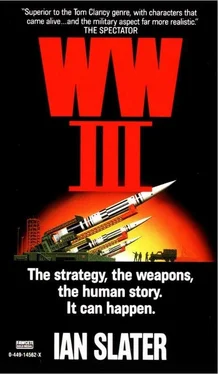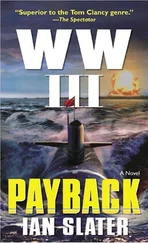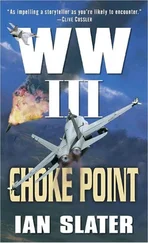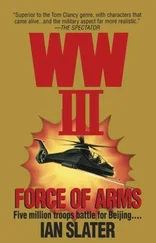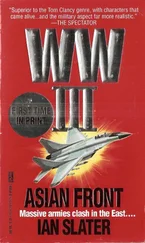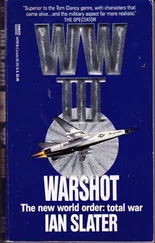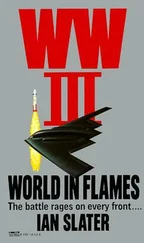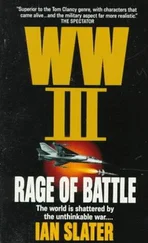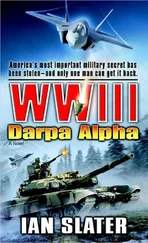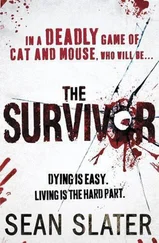Ian Slater - WW III
Здесь есть возможность читать онлайн «Ian Slater - WW III» весь текст электронной книги совершенно бесплатно (целиком полную версию без сокращений). В некоторых случаях можно слушать аудио, скачать через торрент в формате fb2 и присутствует краткое содержание. Год выпуска: 1990, ISBN: 1990, Издательство: Fawcett, Жанр: Триллер, на английском языке. Описание произведения, (предисловие) а так же отзывы посетителей доступны на портале библиотеки ЛибКат.
- Название:WW III
- Автор:
- Издательство:Fawcett
- Жанр:
- Год:1990
- ISBN:978-0449145623
- Рейтинг книги:3 / 5. Голосов: 1
-
Избранное:Добавить в избранное
- Отзывы:
-
Ваша оценка:
- 60
- 1
- 2
- 3
- 4
- 5
WW III: краткое содержание, описание и аннотация
Предлагаем к чтению аннотацию, описание, краткое содержание или предисловие (зависит от того, что написал сам автор книги «WW III»). Если вы не нашли необходимую информацию о книге — напишите в комментариях, мы постараемся отыскать её.
In Europe — Twenty Soviet Warsaw Pact infantry divisions and four thousand tanks begin to move. They are preceded by hundreds of strike aircraft. All are pointed toward the Fulda Gap. And World War III begins…
WW III — читать онлайн бесплатно полную книгу (весь текст) целиком
Ниже представлен текст книги, разбитый по страницам. Система сохранения места последней прочитанной страницы, позволяет с удобством читать онлайн бесплатно книгу «WW III», без необходимости каждый раз заново искать на чём Вы остановились. Поставьте закладку, и сможете в любой момент перейти на страницу, на которой закончили чтение.
Интервал:
Закладка:
The top floor of the Grand People’s Study House, Freeman had told the marines, would command a sweeping panorama of the city through infrared binoculars, and it was taken by a squad of marines without opposition as the helos kept landing and the remaining Apaches, loaded with antitank and thousands of small antipersonnel mines, made what they called, in General Freeman’s lexicon, a “ring around the craphouse,” using Kim II Sung Square as the center aim point. From the twenty-two-storied Kim II Sung University on the northern outskirts to Pyongyang Station on the south side through the Victorious Fatherland Liberation War Museum far to the west of Kim Il Sung Square and back around East Pyongyang Stadium, the Apaches led two of the big Chinooks, which laid a string of explosives, while in the square, four of the eight American Motors Hummers, or Humvees, as the troops called them, came down, slung under the last XC Chinooks. Once unhooked, the Humvees, equipped with a.50 machine gun and infrared swivel antitank launcher in the back, were quickly manned by driver, co-driver, and six men armed with SAWs — squad automatic weapons— and demolition charges. Two of the four Hummers that had not made it to the square were totaled, their parent Chinook striking a tree and overhead wires near the History Museum, sliding and tumbling down the embankment into the Taedong River. The other two Hummers had been aboard a Chinook when, only forty feet above the ground in front of the Grand People’s Study House, it collapsed in a sudden wind shear. In the occasionally flare-lit air, it looked like some great, exotic brown cucumber broken in the middle, its quiet poof of flame starting to spread quickly. A marine sergeant thrust his M-16 at the nearest man, went in under the wreckage, crawling into the Hummer’s cabin. Slithering across the rain-slicked vinyl seat, he was unable to raise his head any higher than the steering wheel because of some part of the chopper’s fuselage sticking in through the driver’s window.
“Where’s he goin’?” shouted another marine.
“Fishing!” another shouted, his mood of bonhomie the result of having passed from sheer bowel-freezing terror into a reverie of relief at still being alive.
The Humvee came to life, jerking out from the wreckage, dragging pieces of fuselage with it.
“On his honeymoon,” someone else shouted. The buoyed mood of the men was caused not simply by the lack of any determined resistance on the ground, evidence of the fact that so far Freeman’s gamble of surprise had paid off, but because of the absence of any vehicular traffic that might be bearing NKA. The magnificently spacious streets around the square were deserted, a possibility that Freeman had privately entertained from the SATINT he’d studied so closely aboard the Saipan. But it was a hope that he knew could be ended any moment by a sudden convoy of infantry coming up from the south or, if the Chinese were still supplying the NKA through Manchuria, troops from the north. Nevertheless, for the moment it was a surprise that helped mitigate the loss of the three Hummers and the crews of the downed Chinooks. Once he was sure the perimeter from the river up past the museum, around the People’s Study House and back to the art gallery, was secure, Freeman sent out three Humvees to complete the next phase of Operation “Trojan.”
One of the Humvees, its nine men all wearing infrared goggles and hunkering down, except for the machine gunner and the ATGM operator, headed north from the square along Sungni Street, swinging left on Mansudae Street. In the last of the flares dropped by the Tomcats, who were low on fuel and returning to sea, their position taken up by Shirer and the second wave, the marines could see the dim outline of the Arch of Triumph half a mile or so away. But their interest centered on the sixty-six-foot-high brown statue of Kim II Sung in front of the Museum of the Korean Revolution. Off to their right they could see Chollima statue, the winged black horse, peasants joyously riding it, Marxist holy book held aloft, the book invisible in the rain.
It took the demolition team four and a half minutes to place the plastic hose cylinders around the dear and respected leader in front of the Museum of the Korean Revolution and another two minutes to insert the wire and run it back off the spool, several hundred yards to where the Humvee had been stationed as an advance guard.
“I don’t like this,” said one marine. “Too fucking quiet. Where’re all the people?”
“Inside, you dummy. ‘Where would you be?”
“Come on — hurry it up,” cut in the corporal as they hoisted the spool aboard the Hummer and drove slowly in the direction of the trees that hid the Grecian facade of the Pyongyang Art Troupe Theatre across the wide boulevard.
“Okay,” said the corporal, “let’s do it.”
There was a dull thud, the ground trembled, and the blast rustled the wet ginkgo trees, water coming off them in a spray, and the air filled with dust that quickly fell in the rain. Kim II Sung was no more.
The driver of the second Hummer lost his way, his navigator rifleman giving wrong directions, so that now they were headed toward the Pyongyang Seafood Direct Sales Shop several blocks up from the square by the river.
“Where the fuck are we?” someone shouted.
“Gooks — dead ahead!” A police car, its Klaxon squawking, its blue light flashing urgently, was tearing down Okryu Street, wet leaves flying up behind it, orange sparks seeming to come from its interior. Small-arms fire.
The Humvee’s.50 Browning stuttered, hot casings steaming through the rain. The police car wobbled, then careered wildly, ran across the street, struck the curb, rolled, ending up on its side, wheels still spinning. A man came scurrying up from the cabin like someone trying to escape from a submarine. The Browning stuttered again and he slumped back, arms caught in the door in a V, the fire licking at the rear wheels.
The marines had another look at the map. “Christ, you’re nowhere near it, Smithy.” It was a gross exaggeration — in fact, the driver had only overshot a right turn past the seafood building by less than a hundred yards.
“Back ‘er up,” the corporal ordered, and after thirty seconds ordered, “Now turn right and straight ahead.”
It was another couple of minutes and they were on the western side of the east-west Okryu Bridge, which spanned the wide Taedong River and was one of the two main bridges by which any counterattack from the east would most likely come. The driver still felt spooked by the apparently deserted city, which till now had not offered any resistance on the ground to the landings in its main core, even though the sound and fury of the air battle was enough to awaken the dead, sonic booms rolling overhead — at times so loud, they were mistaken for the monsoon’s crashes of thunder. To the north, the marines could see forked lightning reaching right down to the hills.
The third Humvee had already reached Taedong Bridge, half a dozen blocks or so to the south of Kim D Sung Square, and the demolition team had started laying their charges when the first of three NKA armored cars started across me old wide span, the armored vehicles’ ghostly outline visible for only a second in the light of a flare. The antitank rocket fired from atop the Hummer — the distance to the armored cars no more than three hundred yards — exploded against the bridge railing. The armored cars kept coming, their machine guns now spitting fire and finding their mark, the marine driver and machine gunner thrown back hard against the canopy, dead, the antitank missile operator behind them taking second aim. The lead armored car’s machine gun opened up again, and the AT operator fired. The lead armored car burst into flame, followed by a sound like falling pots and pans as the vehicle stopped. Without hesitation the second armored car behind the first broke out and took up the attack. The third armored car braked, using the first car’s wreckage as good cover, barely showing its main gun. The new lead car fired its main gun and the Hummer leapt into the air, the AT man dead.
Читать дальшеИнтервал:
Закладка:
Похожие книги на «WW III»
Представляем Вашему вниманию похожие книги на «WW III» списком для выбора. Мы отобрали схожую по названию и смыслу литературу в надежде предоставить читателям больше вариантов отыскать новые, интересные, ещё непрочитанные произведения.
Обсуждение, отзывы о книге «WW III» и просто собственные мнения читателей. Оставьте ваши комментарии, напишите, что Вы думаете о произведении, его смысле или главных героях. Укажите что конкретно понравилось, а что нет, и почему Вы так считаете.
